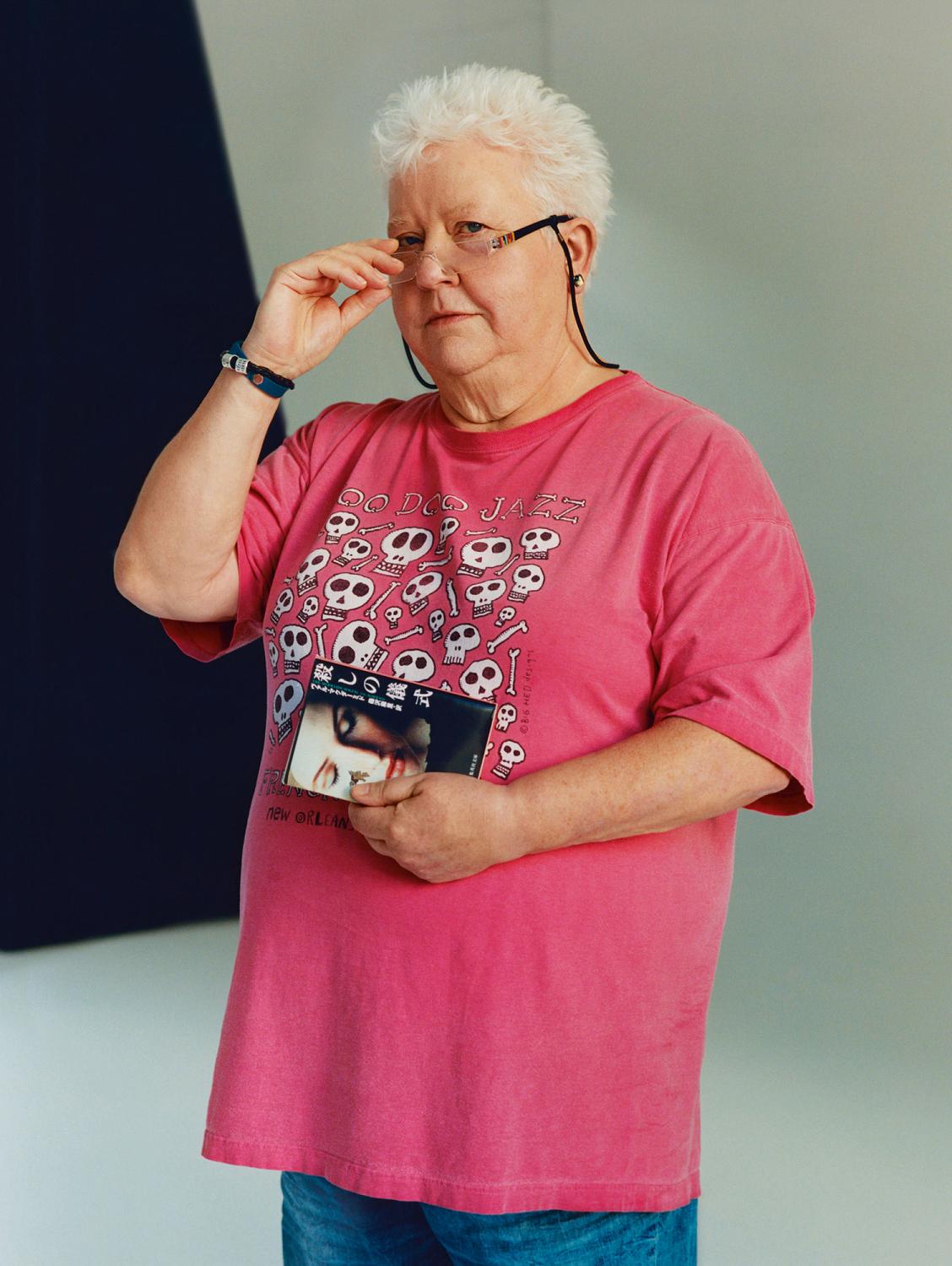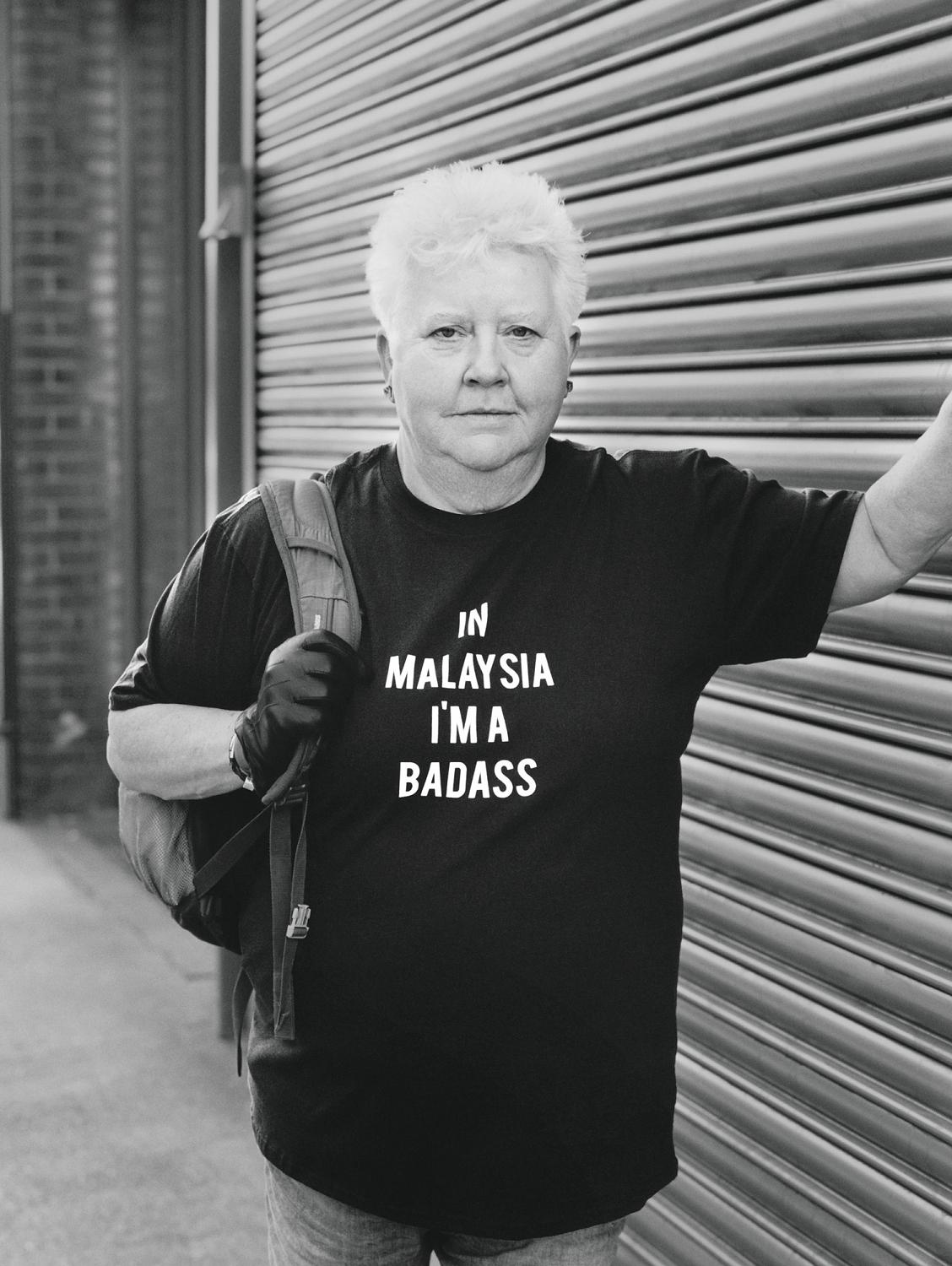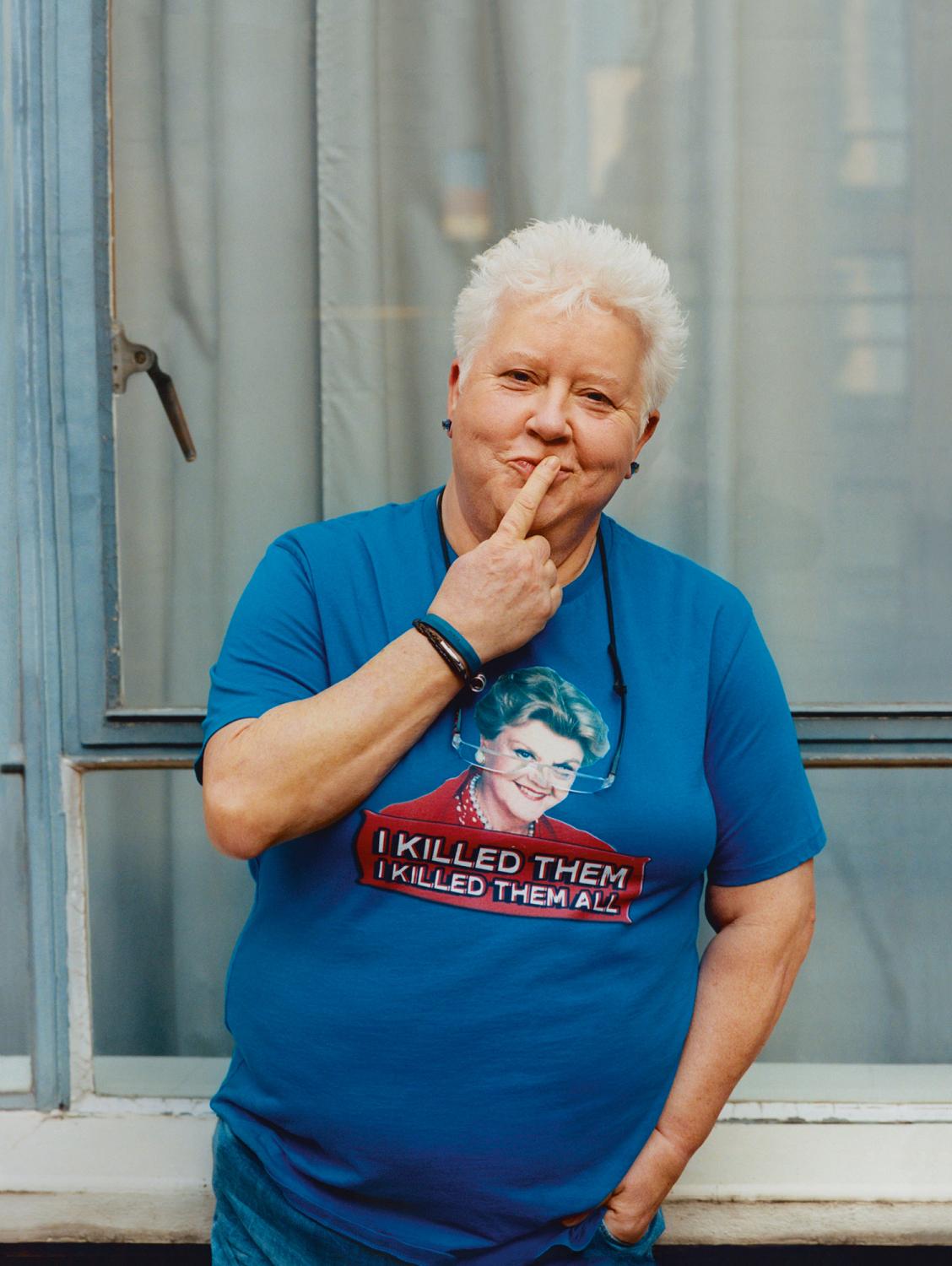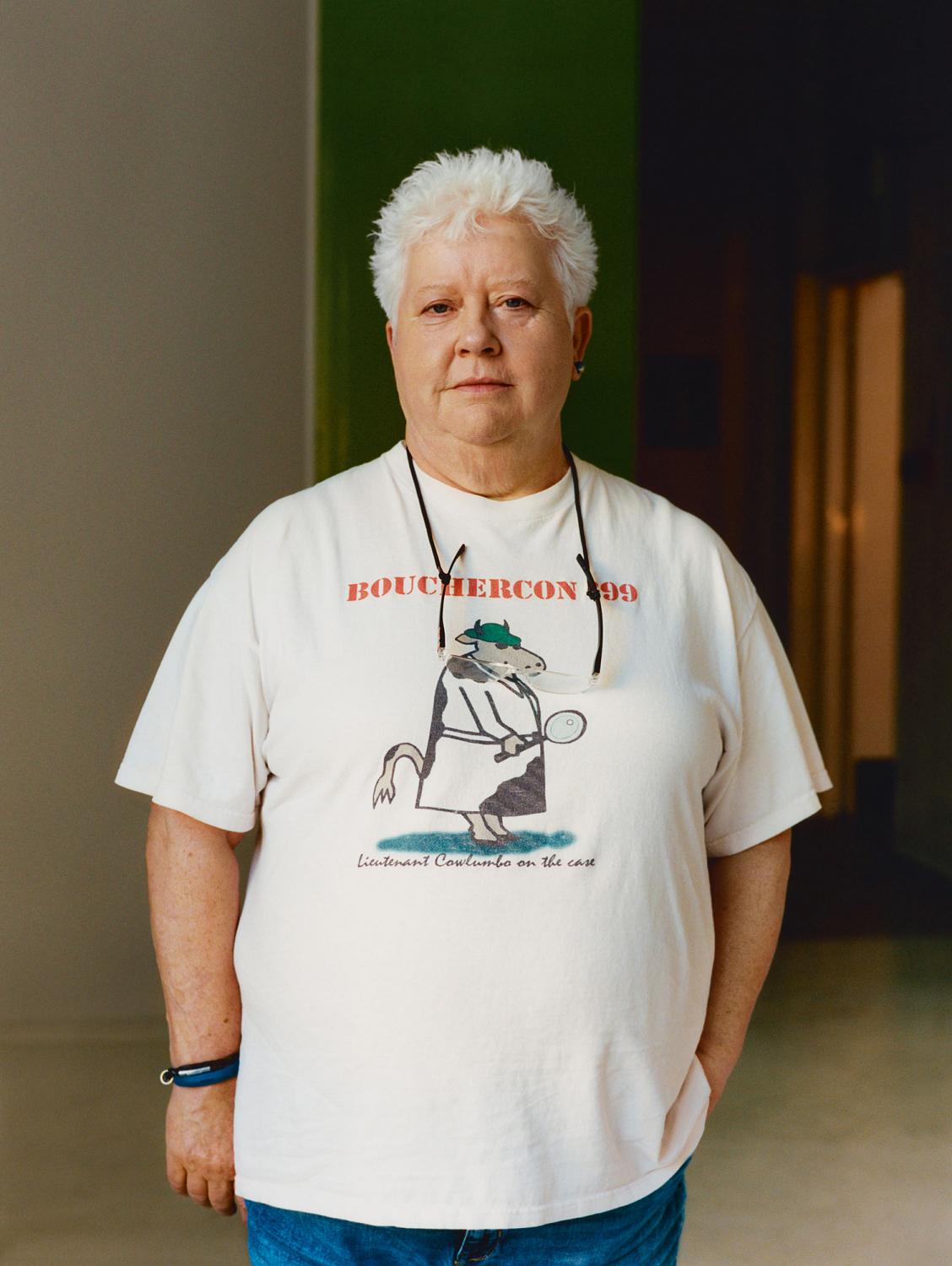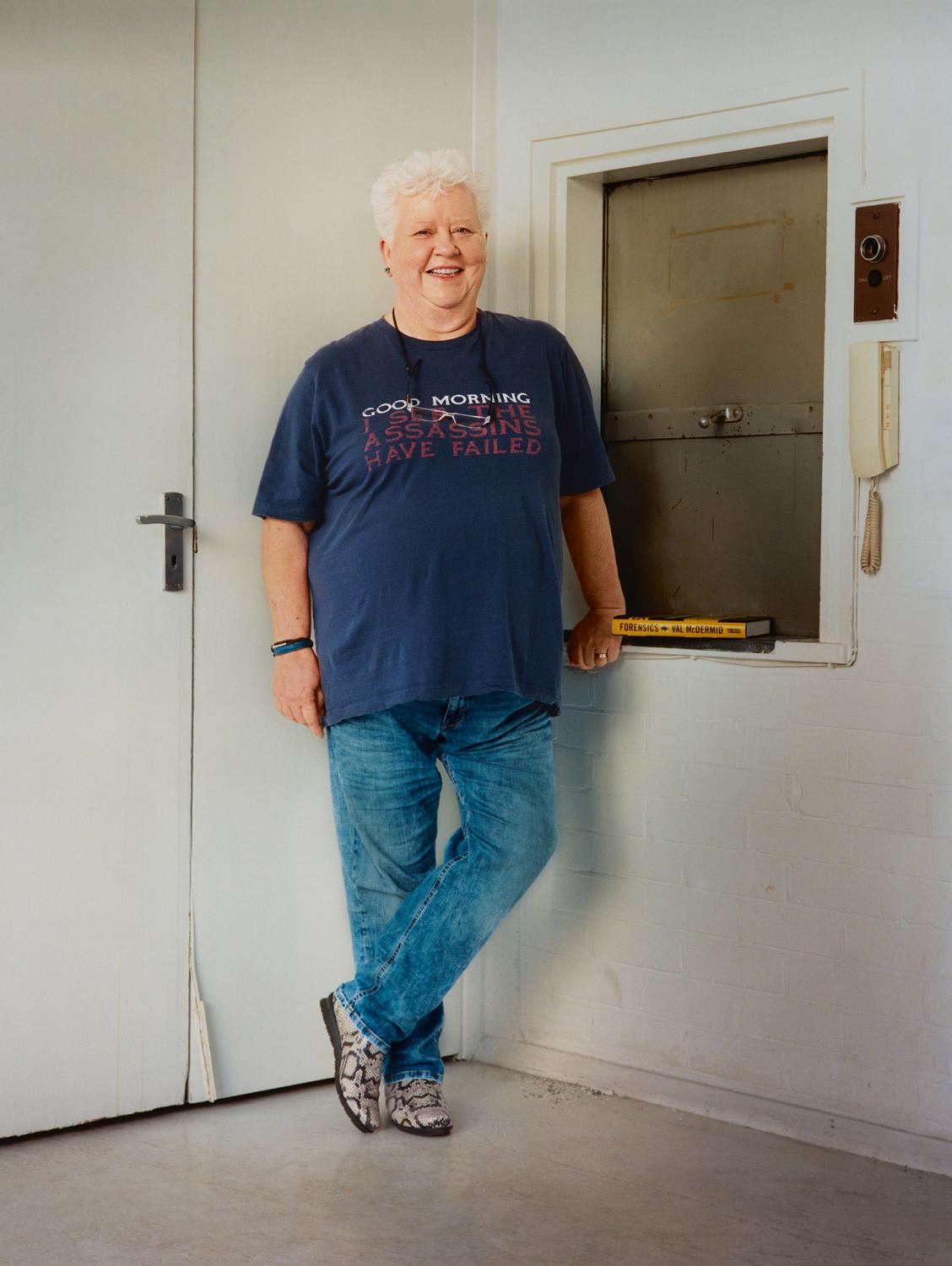The Wardrobe with Val McDermid
Val spends the winter holed up writing, but for the remainder of the year you’ll often find her on the road, guesting at literary festivals and crime conventions. This favourite T-shirt was purchased in New Orleans in 2004, when she was inducted into the Hall of Fame at Saints and Sinners, an LGBT literary festival. “I liked the skulls and the bones because they’re light-hearted and a bit cartoonish.”
Val’s Twitter account is friendly, informative and, on political issues, resolutely even-tempered. But everyone has an off day. “One guy just caught me on the wrong morning — I hadn’t had my second cup of coffee — and he said, ‘I’ve enjoyed several of your books, but now that I’ve discovered you’re a #feminist, I’ve decided not to buy/read any more of them.’ I just tweeted back a little bit of a slap-down. It went viral, ending up with about a quarter of a million retweets. Then Elle Malaysia nominated me as ‘badass of the month’. So my team at Little, Brown printed this as a surprise.”
“Elle Malaysia nominated me as ‘badass of the month’ — fabulous!”
Whenever Val wears this T-shirt, she’s repeatedly asked where she bought it (redbubble.com). “Would you go to tea in Cabot Cove?” she asks. “I don’t think so!” Val is a far cry from Scotland’s answer to Jessica Fletcher — though she is a big fan of the inherent implausibility of Murder, She Wrote. “Today, there’s far more scope to crime writing,” she says.
“Would you go to tea in Cabot Cove? I don’t think so!”
At 18 years of age, this is one of the oldest and most treasured T-shirts in Val’s collection. The bovine detective Lieutenant Cowlumbo was the 1999 mascot of Bouchercon, the World Mystery Convention. “It moves around each year,” Val says. “That year it was in Wisconsin, in Milwaukee, which is home to the American dairy industry. So it was either this T-shirt or a piece of cheese.”
Val has published 31 crime novels, sold 15 million books, and been translated into more than 30 languages. She has five main characters to whom she returns — Tony Hill and Carol Jordan (10 terrifying tales), Kate Brannigan (six), Lindsay Gordon (six), and Karen Pirie (four).
“This is a great T-shirt for wearing at festivals, especially when you come down to breakfast,” Val says. Not that she’s a candidate for assassination. On the contrary, perhaps we should be careful of her. As the chair of the New Blood panel at the Theakston Old Peculier Crime Writing Festival, Val spends weeks shortlisting four debut novelists for a group round table at the event. “I start off by saying what a privilege it is to read these and conclude with how it’s useful to know what new talent to throw under the bus.”
“People expect crime writers to be as dark as their books.”
When Val McDermid’s fans recount tales of sleeping with the lights on after reading one of the 15 million books she’s sold, it’s evidence that her position as Scotland’s queen of crime is in no danger. Under interrogation, this expert on the dark side reveals a fiercely intelligent and gregarious persona – one that’s characterised by a love of a statement T-shirt and a passionate advocacy for her craft. So let’s take a trip to Val’s stalking ground to find out where the bodies are buried.
You might consider a strip-lit interview room down the local nick or, better yet, a quaint tearoom filled with tinkling china and home baking to be a fitting place to interrogate one of Britain’s best-known crime writers. But no. Val McDermid, 62, has requested that we meet in the top-floor cafe of the newly refurbished John Lewis in her home town of Edinburgh, a venue that makes up for any lack of character with panoramic views over the capital’s slate rooftops. “It’s good for people watching,” she says.
2017 marked the 30th anniversary of the publication of Report for Murder, Val’s first novel. She has since sold more than 15 million books in 30 different languages. Her 31st, Insidious Intent, was published last September. It sees the return of the criminal psychologist Tony Hill and Detective Chief Inspector Carol Jordan, who together have been the protagonists of 10 of Val’s books. The first in the series, The Mermaids Singing, won the Crime Writers’ Association’s prestigious Gold Dagger in 1995. The second, Wire in the Blood (1997), was made into an ITV series, its six seasons broadcast from 2002 to 2008.
One of the UK’s most prominent cultural figures thanks to her warm, no-nonsense participation in TV panel shows such as Question Time and University Challenge, Val’s never been one to conform to the familiar tropes of the hard-boiled crime writer. Report for Murder, which featured the journalist Lindsay Gordon, was the first British crime novel with a lesbian protagonist. “I didn’t really think about it as an act of bravery,” Val says in her rolling Scottish accent. “She was my central character, the investigator, and she happened to be gay. That was my biggest fight, editorially,” she adds. “Lindsay’s a national newspaper journalist. She’s a bit flash. She knows she’s a bit flash; she drives a sports car. So when my editor earnestly asked, ‘Don’t you think it would be better if she drove a 2CV?’ I was like, ‘No! You’re just not understanding the first thing about that character.’ I very deliberately wrote those books to appeal to a wider audience. I don’t want to live in a ghetto; I don’t want to write in a ghetto.”
For the past 15 years, Val has been meeting her audience in person as a co-founder of the Theakston Old Peculier Crime Writing Festival in Harrogate, Yorkshire, an event that has significantly raised the genre’s profile and standing in literary circles. “People who are into crime fiction tend to read a serious amount,” Val says. “And they expect crime writers to be as dark as their books. But there’s another side to me. Often after I’ve given a talk, people say, ‘I was shocked by how funny you are.’ The T-shirts are part of it.”
Val discovered her style as a guitar-playing teenager and says her customary uniform of jeans and T-shirt hasn’t altered substantially since then. She normally has 25 to 30 printed T-shirts on the go. “I do cull them regularly – you know how they stretch or shrink. Then I’ll get three new ones and they go into rotation,” she tells me. “If I love something, I’ll wear it until it’s falling apart.”
Clothing can be a useful shorthand for describing characters, she says. “You do read people through what they’re wearing. We all make judgements in that way. But if you’re going to be a good writer, you have to suck up everything – what people wear, how they behave, body language – and then draw conclusions from it.” So what can the criminal profiler infer from the Zamberlan hiking boots and down-filled jackets from Rab that Val likes to wear with fine merino underlayers? The technical gear points to a love of long country walks and afternoons spent in the McDermid Stand at Stark’s Park, the home ground of Raith Rovers FC. Val served as a director from 2007, stepping down last year. Her father, James, had been a scout for the club, and since 2010 Val has sponsored the North Stand in his honour. She also sponsors the home shirts for the first team and the under-10 girls. “And I’m very happy that in November, Raith Rovers took the field with rainbow laces, and the captain with a rainbow armband,” she says. “Slowly but surely, football is becoming more inclusive. But it’s entirely unbelievable that there isn’t a single out gay footballer in the Premier League in England or Scotland.”
Val hails from Kirkcaldy, in the heart of the Fife coalfield. The small town is famous for being the birthplace of the economist Adam Smith and, more pungently, of the manufacture of linoleum. Val was the first student from a Scottish state school to be accepted at St Hilda’s College, Oxford, where she read English language and literature – and, at 16, one of the youngest ever. After graduating, she spent 16 years as a journalist, ending up as the northern bureau chief of The People. In a memorable interview for Desert Island Discs in 2013, Val was asked about the nickname Killer, which she’d been given by the newsroom at Scotland’s influential tabloid Daily Record in the 1970s. “I just went out and got stuff done,” she deadpanned. “Always got the stories.”
One of her tricks as a journalist to gain access to locations that were off limits had been simply to ask to use the loo. “That got me across a lot of doorsteps. As a woman, it’s very hard for people to be horrible if they can see you’re desperate to go. And once you’re in, you start absorbing information. Is the carpet threadbare? When did they last wallpaper? When did they last clean?
“Sometimes you have to work hard with not very much information, but journalism gave me a huge database of people, places and environments that I wouldn’t have got in any other way. I still do it in the world,” she adds. “I get on the bus in Edinburgh, watch the passengers, listen in on the conversation going on behind me. If I don’t think about walking in somebody else’s shoes, then I’m not doing my job right.” Though, she says, “my profile has got to a point where a lot of people recognise me. It’s a disadvantage.”
Her shock of white hair may be the greatest threat to Val’s anonymity, but it received a surprise celebrity endorsement recently at a party where Blondie were performing. “I was just inches away from Debbie Harry as she was singing ‘Atomic’. And that part where she goes, ‘Your hair is beautiful’? Well, she leant forwards and looked me straight in the eyes as she sang it. And I’m wondering, did I just dream this? I’ve been in love with you for 40 years!”
Aside from Debbie Harry, Val has finally found someone who understands her hair – a female barber, Wendy Brown at HIM Grooming, who worked at the bottom of Val’s building when she first moved to Edinburgh. “I could see from the guys coming out that she cut hair really well, but when I asked her to do mine, she said she didn’t do women except for family and friends. So I said, ‘Well, can we be friends?’ And she’s done it ever since.”
Val divides her writing time – “January to March or April” – between Edinburgh’s elegant Georgian suburb of Stockbridge, where she lives with her partner, Jo Sharp, a professor of geography at Glasgow University, and Heaton Moor, Stockport, where she shares custody of her son from a previous relationship.
“If you’re serious about writing good crime fiction, you have to be serious about writing characters who are experiencing difficult emotions, such as grief, loss, pain, betrayal,” she says. “To do that well, you have to go back into your own experience: what impact did that have on my daily life? How did that transform me? You’re constantly living the life examined.” The details that give her books the hallmark of authenticity can come from anywhere. She mentions her friend Andrew Taylor, who wrote a series set in the 1950s and whose research material came from his mother’s account books. “You know, like ‘3lb potatoes, 1s 6d’,” Val says. “Those household accounts are a mirror on what was spent on the day-to-day.”
Val has a sentimental fondness for Agatha Christie; her favourite is The Murder at the Vicarage, published in 1930 and the first to feature Miss Marple. “It’s a tremendous piece of work, technically,” she says. “When there’s not much going on in the main story arc, there’s something to distract you in all the subplots that interlock. Christie’s often criticised for her characterisation,” she continues, “but I don’t agree. There’s this wonderful line that goes something like, ‘Miss Hartnell was weather-beaten and jolly and much feared by the poor,’ and you know exactly what she was like, just from that one killer line.”
When Val started out, most crime fiction in the UK was either “cosies” of the Christie school or police procedurals. Now there’s range and scope to the genre, which she promotes as chair of the New Blood panel at Harrogate. It goes through phases. “I think we’re done with ‘The Girl’,” she says, referring to Stieg Larsson’s Millennium Trilogy. “That great wave of Scandinavian noir broke, and now what remains are the really good writers; the middling talents have fallen away.” Val also suspects the trend for domestic suspense has had its day. “You know, there’s a dark secret from the past that threatens their lives in the present, usually something to do with a partner or an ex – The Girl on the Train, that sort of thing.” With historical crime novels like Graeme Macrae Burnet’s His Bloody Project and Denise Mina’s The Long Drop so popular, Val wouldn’t be surprised if this is the next wave – “reworking real cases into fiction, novels purporting to be real crimes.” But she writes only the books she wants to write. “I’m resolutely unfashionable, you see.”
Val may have been there, done that; she’s certainly got the T-shirt. But she’s not complacent about her success. “It’s the duty of any writer to make people think and to give them pleasure in the process,” she says. “Otherwise they’d be reading Das Kapital. You want people to read your work, but pretty much all the writers I know exist in a miasma of self-doubt. I’ve never been satisfied with anything I’ve ever written — and I hope I never am.” A good proportion of her time is taken up by running a lively website and maintaining an entertaining social media presence, all designed to direct people towards her work. “The books are what it’s all about. For any serious writer. Everything that you do is about getting people to read your work.”
Andrew TuckerThe writer Andrew Tucker lives in leafy Shepherd's Bush, west London. A dropout from fashion school in the ’90s, Andrew eventually carved a career in fashion through his ability to turn his hand to anything. Andrew has consulted on a number of creative projects for the British Fashion Council, has…read more Photography by
Paul WetherellPaul Wetherell is a photographer from London who is renowned for his sensitive portraiture and elegant fashion stills. His photography has appeared in many publications such as Another, Fantastic Man, i-D, UK Vogue, WSJ and 10. He is represented by the quite fabulous Julie Brown at M.A.P., who can be…read more Styling by
Eliza ConlonBorn and raised in Peckham, south London, the qualified art therapist and empathic stylist Eliza joined The Gentlewoman in 2018. Hooray! Her other clients include Acne Studios, Stella McCartney and Talia Byre. Eliza is passionate about using fashion and clothes as a creative outlet for the neuro-diverse,…read more
Make-up: Jo Gillingwater at One Represents. Photographic assistance: Chris Miller, Sam Wilson.
This profile was originally published in The Gentlewoman nº 17, Spring & Summer 2018.